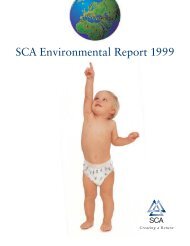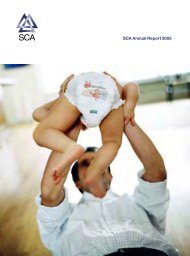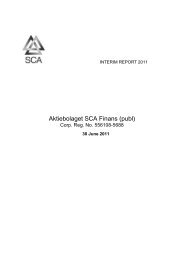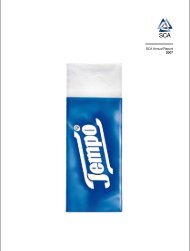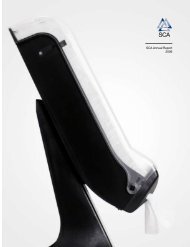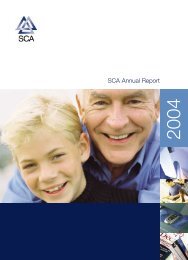Annual Report 1998
Annual Report 1998
Annual Report 1998
You also want an ePaper? Increase the reach of your titles
YUMPU automatically turns print PDFs into web optimized ePapers that Google loves.
4<br />
Cash flow and dividend growth<br />
Our operations are always keyed to the objective of giving our<br />
shareholders a competitive return on their investment. The<br />
strategy for creating growth in value is based on being able to<br />
use the cash flow from operations for dividends and for profitable<br />
strategic investments. These investments in turn create a<br />
growing cash flow that strengthens the base for consistent<br />
growth in dividends.<br />
In conjunction with the Board’s strategy review of the<br />
Group, the Board concluded that the current Group structure<br />
and earnings capacity supports a somewhat higher dividend<br />
level in <strong>1998</strong> in relation to reported shareholders’ equity. The<br />
Board has proposed an increase in the dividend for <strong>1998</strong> of<br />
13 percent.<br />
Since the company was listed on the Stockholm Stock Exchange<br />
in 1950, SCA’s dividend has been raised continuously<br />
or kept unchanged. Growth in the dividend during the most<br />
recent five-year period, including the dividend proposed for<br />
<strong>1998</strong>, has amounted to 14 percent. The dividend today is equal<br />
to approximately 4.9 percent of the shareholders’ equity’s<br />
book value.<br />
Outlook for 1999<br />
Development in 1999 is difficult to assess, but the relative<br />
stability of economic growth in Europe and the US provides<br />
some cause for optimism.<br />
Volume growth for SCA products in <strong>1998</strong> was strong while<br />
price pressure in virtually all areas occurred. Competitive<br />
pricing was also noted for both raw materials and finished<br />
products. Raw materials, however, were also affected by surplus<br />
supply caused by the financial crises in Asia and Latin<br />
America, while price pressure on finished products was caused<br />
by low inflation and competition in Europe.<br />
Prices for hygiene products at year-end <strong>1998</strong> were 1–3 percent<br />
lower than average prices for the year. Pulp prices also declined,<br />
which compensated for most effects of lower prices for<br />
3,000<br />
2,500<br />
2,000<br />
1,500<br />
1,000<br />
Importance of forest raw material<br />
to SCA’s competitiveness (Sweden)<br />
500<br />
0<br />
Operating profit, SEK M<br />
–500<br />
1988 1989 1990 1991 1992 1993 1994 1995 1996 1997 <strong>1998</strong><br />
Forest raw materials SCA’s production industry<br />
in Sweden<br />
The forest operations are of major importance for SCA’s cost situation and quality orientation.<br />
The stable earnings level of the forest operations over time also offset the more varying earnings of the<br />
Swedish industry, primarily within Packaging and Graphic Paper.<br />
finished products during the fourth quarter. Internal programs<br />
to improve productivity will be intensified in 1999 and are expected<br />
to gradually improve margins by 2 percentage points<br />
over the next two years. Demand is expected to remain strong,<br />
and determined efforts will be made to restore higher prices.<br />
In the Packaging business area, the prices for corrugated<br />
board were relatively stable toward year-end but at the beginning<br />
of 1999 volumes were weaker and prices were under pressure.<br />
Prices at the beginning of 1999 were 2 percent lower than<br />
the average in <strong>1998</strong>. Prices for both kraftliner and testliner declined<br />
toward year-end and, in the beginning of 1999, were<br />
about 5 percent below average prices in <strong>1998</strong>. An increase of<br />
15 percent in the price of kraftliner has been announced by<br />
North American producers. Conditions for a price increase in<br />
Europe during the second quarter are considered good.<br />
Within the Graphic Paper business area, price uncertainty<br />
prevails. The price situation for SC paper is projected to remain<br />
stable, while newsprint and LWC are facing price pressure.<br />
The price of LWC paper in the beginning of 1999 was<br />
about 3 percent below the average price in <strong>1998</strong>. Demand for<br />
coated fine papers in sheets is strong, but prices in the beginning<br />
of 1999 were about 5 percent below average prices in<br />
<strong>1998</strong>. Pulp prices appear to have hit bottom.<br />
A number of strategic acquisitions and expansion investments<br />
were carried out in <strong>1998</strong>. These investments will<br />
generate increased cash flow. Accordingly, the cash flow goal<br />
for 1999 was adjusted upward to SEK 7.0 billion (operating<br />
cash flow) and SEK 3.8 billion (cash flow from current operations).<br />
This is also described in “Business control and financial<br />
goals” on page 6.<br />
Stockholm, 19 February 1999<br />
Sverker Martin-Löf<br />
President and Chief Executive Officer<br />
30<br />
25<br />
20<br />
15<br />
10<br />
5<br />
Effective return on the SCA share<br />
based on time held and average share prices<br />
%<br />
0<br />
1980<br />
1985<br />
Average 15 %<br />
1990<br />
Average 17 %<br />
DATE OF ACQUISITION<br />
1995<br />
The diagram illustrates the annual effective return, through <strong>1998</strong>, based on the date of acquisition of<br />
the SCA share. For example, if the SCA share was purchased in 1996, the effective return through<br />
<strong>1998</strong> amounted to 25%. Effective return is defined as the share’s appreciation in value and the annual<br />
dividend being continually reinvested in SCA shares.<br />
The horizontal lines show that the average over the entire period is 15% and 17% for the past five<br />
years.




